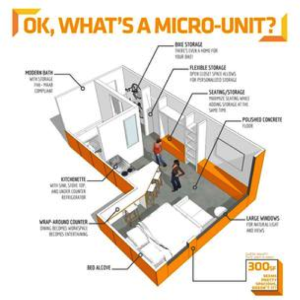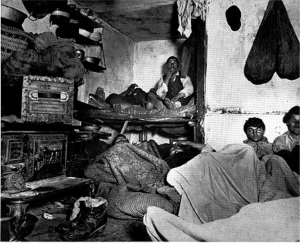Periodical: Metropolis
Thesis: Micro Units in dense urban environments can succeed in recognizing the changing dynamics of the modern household composition, and accommodating for the high demand of single-person homes.
Evidence: Since the 1940’s, the number of U.S one-person households has raised 48% (Source: Census). The composition of a household, when compared to 70 years ago, has changed drastically, life expectancy has increased, adults defer starting families, and young adults live with their parents longer. Major cities have seen a constant influx of demand for one-bedroom apartments, creating housing shortages across the globe. In London, 1 in 10 people are on housing waiting lists, and in China, 10 million apartments would have to be built every year until 2030 to fix the current lack of sufficient urban living quarters (Source: Galante).
Micro Housing is not a new idea, but the concept needs to be re-invented and re-branded. The aim is to provide affordable and efficient housing for individuals, or couples that wish to live on their own, in desirable locations that might otherwise be out of their income range. When looking at the trends of the Millennial Generation, marriages are delayed a full five years compared to a decade ago, suburban life is generally rejected, in favor of cities with vibrant arts and entertainment scenes, and many are already in debt from student loans. This creates a constant influx of young adults, between the ages of 24-29 that have a median income of $31,000 a year, who have very little housing options catered to their demographic (Observer). Picturing any major city in the world, this demographic represents an incredibly large amount of its population. Creating units that cater to this demographic is important not only to solve housing shortages, but also to integrate communities back into previously unattainable parts of the city.
A historical example of the idea behind micro-units is the Nakagin Capsule Tower designed by Kisho Kurokawa in Japan which was completed in 1972, and was conceived of as a solution to urban housing in Japan, dealing with Japan’s transformation from a rural to a modern society. The 140 capsules were just over 100 square feet built modularly with the intent that they could be replaceable and adaptable reflecting the rapidly changing society. This was an early example of the idea behind tiny modular apartments, and can be used as both a “what to do” and “what not to do” for modern day micro units.
The units vary in size depending on the project, but are typically less than 350 square feet. Micro Units have to have a fully functioning kitchen as well as bathroom. This is what differs Micro Units from other types of single room housing; the units cannot rely on communal kitchens and bathrooms (Urban Land Institute).This is another aspect of micro units that lends itself to the single person user, who wants to have their own space.
Its important that the public perception of Micro- Units be re-branded, this is because there is an image connected to micro dwellings of old tenement housing and the banning of single room occupancies in the 1950’s due to substandard housing conditions. However this led to a gap in affordable housing, creating a large illegal sector and the issue was never actually helped. Micro Units attempt to break this outdated perception and regulation by creating clean safe and convenient accommodations that can be adaptable according to working needs, and which prevent landlords from subdividing the spaces more.
Until recently, micro units were prevented from being built in many cities because of strict zoning codes and restrictions. New York City’s zoning codes did not allow apartments smaller than 400 SF. These restrictions were originally created to end tenement housing in New York City, and were upheld until Mayor Bloomberg announced in 2013 that he would be amending some of the regulations in order to build the cities first micro unit building in Manhattan. Manhattan’s rent prices have been steadily rising for years, in 2013 alone, rising 5.1% to $2,794 for a one-bedroom unit (Bloomberg Business). My Micro NY housing units designed by nARCHITECTS will be located in Kips Bay area of Manhattan. Aiming for completion at the end of 2015, the building consists of modular units fabricated at the Brooklyn Navy Yard (ArchDaily). My Micro NY offers 22 rent-restricted units, that will depend on the tenants income, and 33 market rate apartments. The range will be from $939 to $1,873(Bloomberg Business).
Although not built yet, My Micro NY represents a pivotal moment for urban housing in New York City. If considered successful, more permanent amendments to zoning regulations may be made, in order to continue building more housing. However, for a city so large, which prides itself on innovation, there needs to be a more dedicated approach to solving this housing shortage. My Micro NY runs the risk of becoming a singular attempt because of this half-allegiance to the concept.
There are also logistical advantages to building Micro Units. MPF Research did a study tracking occupancy performance for small units (less than 600 square feet), mid-sized units (from 600 to 1,000 square feet) and large units (more than 1,000 square feet). The study found that in general, the small units had a substantially higher occupancy (Multifamily Research Committee). This means that not only are micro units a logical solution to a growing housing shortage for a specific demographic, they are also relevant to the national trend of downsizing. Micro Units also have higher rent premiums per square foot over larger units (Multifamily Research Committee), which is an incentive for developers to build this type of housing.
In contrast to the slow moving adoption of micro dwellings in New York City, Seattle has become an icon for the Micro Unit, with 3,000 Micro units built so far (Politico). Seattle faces the same issues, a continually increasing demand for single person units, as well as a rise in rent prices in the nicest neighborhoods, creating a housing shortage for younger people working more transient jobs. However Seattle’s concerns also have to take into consideration the continual expansion of the city. Seattle is rapidly growing, while New York City is more inflating. So while New York drags its heels in sorting out its current housing shortage, Seattle needs to plan ahead for the future millennials and techies that will soon swarm the city from the new headquarters for Amazon and Google.
The micro units in Seattle have succeeding in doing what they were meant to do, which is provide affordable housing in good areas of the city, for individuals who would prefer to live alone. With Seattle’s enthusiastic adoption of micro-units, they are facing backlash from neighborhood activists who are angry at the new developments in their neighborhoods. They argue that “sketchy” and undesirable people will be attracted to their neighborhoods, however their arguments are flawed and fueled by unconstructive judgment, They are failing to realize that it would be impossible for the neighborhoods of Seattle to stay stagnant with an expected 70,000 new housing units needed in the next 20 years (Politico). The neighborhood activists that are pushing for a zoning regulation creating a minimum square footage, are only succeeding in raising rent prices, and cutting 10 percent of the affordable housing. Activists also cannot make the argument that their homes decrease in value because of the new neighbors, with neighborhood property values actually increasing when micro units are built (Politico).
On the other hand, a city that should take micro units into consideration as a safety regulation is Hong Kong. Being one of the most expensive cities in the world, real estate prices continue to soar, creating political unrest between the young and the old, with younger generations forced to continue to live with their parents in tight living quarters (Business Insider). The subdivided apartments in Hong Kong are not as restricted by zoning codes as most major cities, which poses a problem for low income families that are crammed into subdivided apartments, sharing with multiple others (City Lab). With some of these apartments as small as 50 square feet, Micro-Units are associated with these unhealthy living conditions, However this happened because landlords continued to subdivide the housing, creating cramped living quarters for families, something micro units are not intended for (The Guardian). Micro Units have specific occupancy regulations, as well as restrictions on landlords subdividing the units, all of which fits Hong Kong’s growing need for single person homes, lessening the need for these subdivided family apartments. Hong Kong serves as an example for the need of government regulation that prevents landlords from further subdividing units, and having units that can only be used for the occupancy intended.
Micro Housing is able to address modern day concepts such as single person households, Rising rent prices, trends in small unit occupancies, Urban Growth, and housing shortages. These are all common factors that almost every major city has in common, and in which micro housing could be beneficial. These cities need to become proactive in their urban housing strategies, and recognize the massive population of single person households that currently do not have a market that applies to them. Micro-Units are the answer to this growing problem, and need to be recognized as a logical, and responsible conclusion, rather than looked at as a regressive trend in urban housing.
Citations






